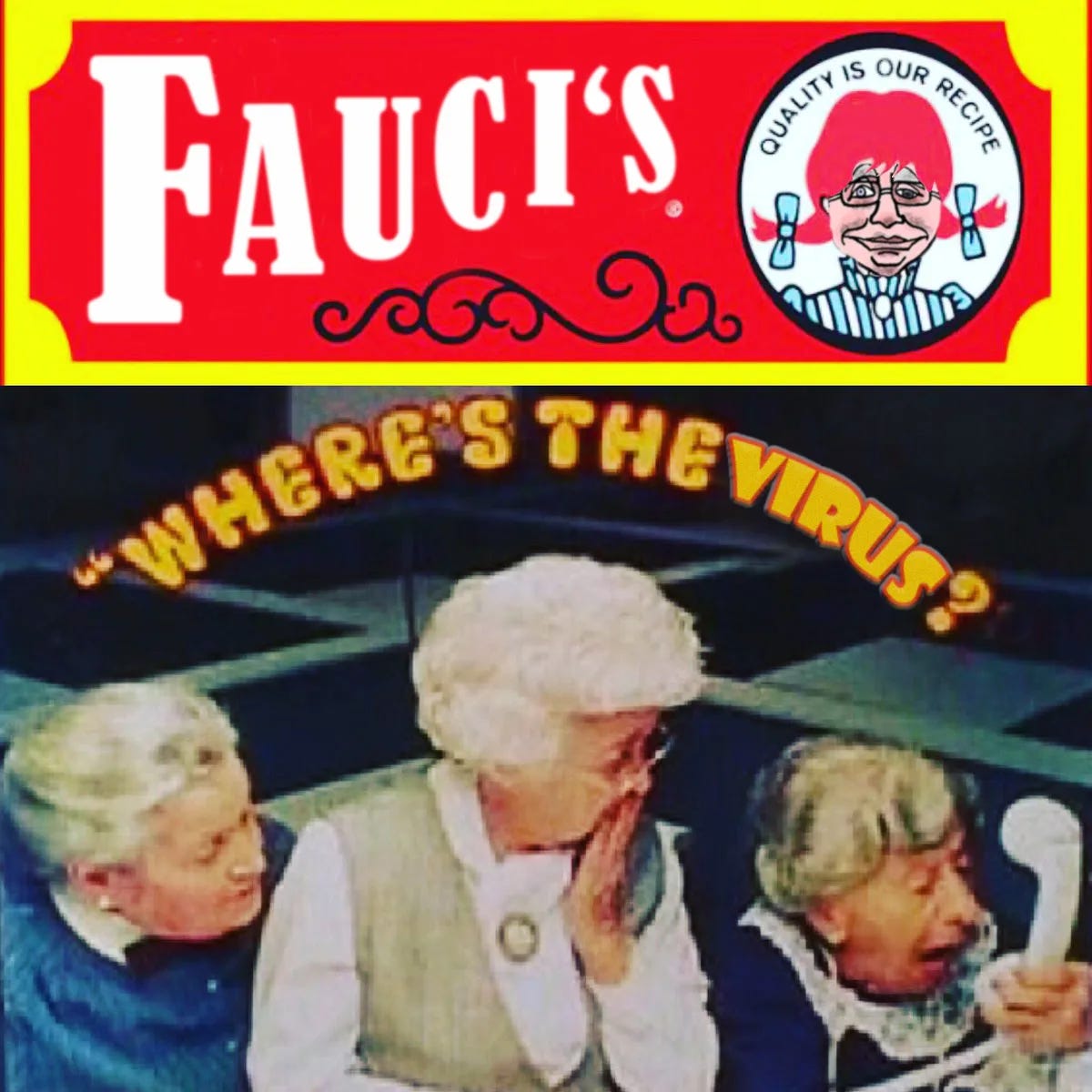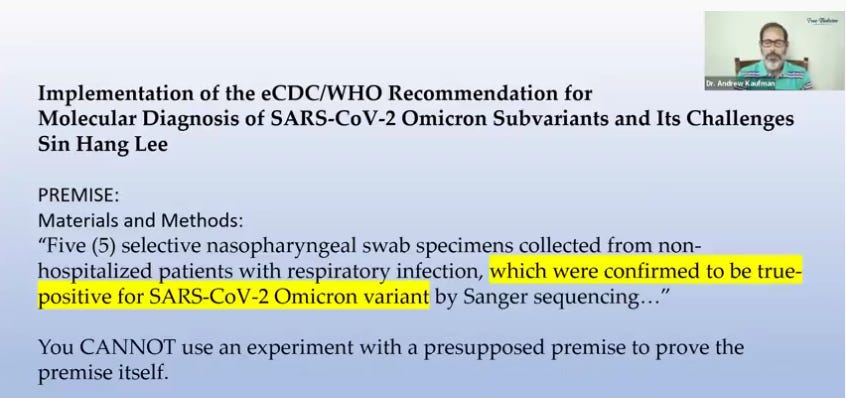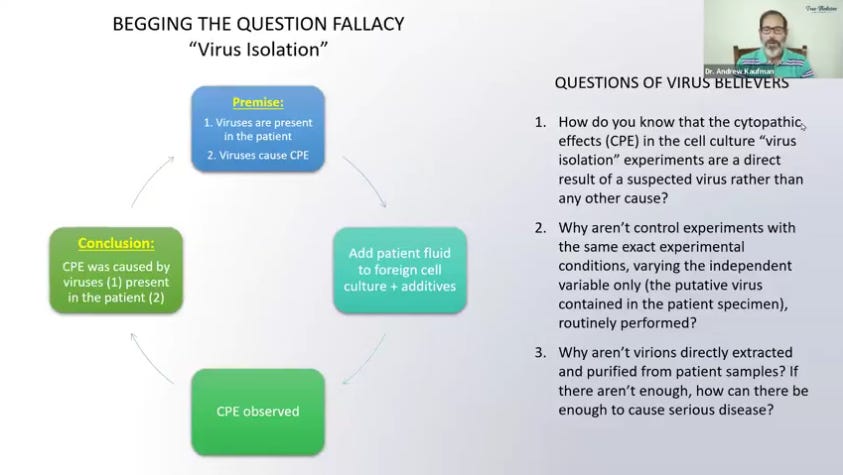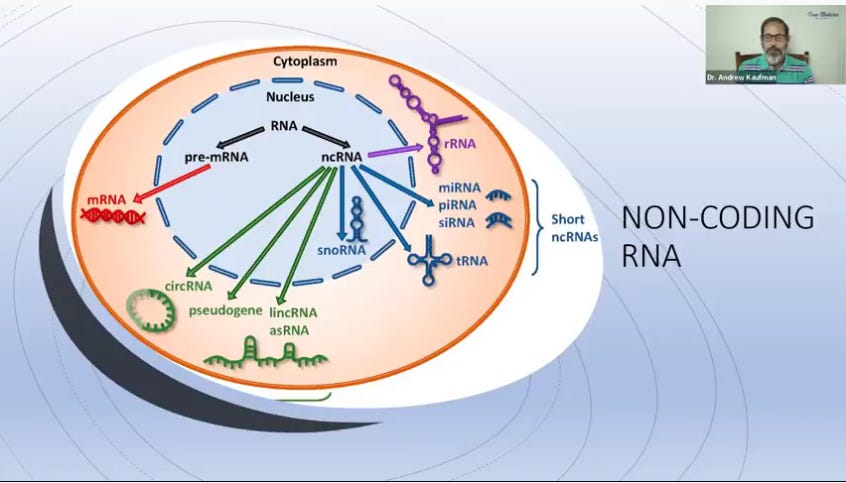A Follow Up to the Virus Challenge
Did this paper meet the challenge? Spoiler Alert: No
Are you old enough to remember or have you ever heard of the Wendy’s “Where’s the beef?” campaign?
I thought this was pretty funny . . . Where’s the virus? … a post from The Good Citizen here on Substack.
On to our topic for today . . .
You may be aware of the Virus Challenge put forth by a number of signatories. If not, you can find details here. To put it simply, the challenge is:
The claim is that viruses, defined as replicating, protein-coated pieces of genetic material, either DNA or RNA, exist as independent entities in the real world and are able to act as pathogens.
We now ask that the virology community prove that these claims are valid, scientific and reproducible.
Dr. Cowan had hoped this challenge would bring forth a response from the virology community to defend their conclusion that the SARS-CoV-2 virus exists.
As Dr. Mark Bailey shares in his recent article, Warnings Signs You Have Been Tricked By Virologists…Again, this email was received by Dr. Cowan:
I have a Preprint manuscript currently under peer review as follows. https://www.preprints.org/manuscript/202206.0192/v1 There is irrefutable Sanger sequencing evidence that the virus exists and keeps mutating. If Dr. Tom Cowan disagrees, please write a critique to challenge my data and interpretation online in the open. I will respond. Other scientists can join in for the debate.
Dr Sin H. Lee, 18 July 2022
Dr. Bailey writes:
Dr Lee’s paper does not even appear to be designed to demonstrate the existence of a postulated disease-causing particle. I sent him several questions including, “I have read the preprint and there does not appear to be a hypothesis presented – is that correct?”, “In your study there did not appear to be any controls (e.g. checking for selected sequences in other nasopharyngeal specimens from humans said not to have the alleged virus) – presumably that was by design?” and “What is your definition of a ‘virus’ in the paper?”
Lee responded, “your questions are irrelevant to you [sic] intention to write a comment or critique on the manuscript involved,” and suggested I write something in the preprint website’s comment section.
My comment: My take on Dr. Lee’s response is that Dr. Lee was expecting a critique of his process related to the genomic sequencing and the challenges related to subvariants, not the premises of the existence of viruses and how that their existence is determined. Just like his paper, he assumes that because the patients tested positive via PCR, that the viral existence was a given. Dr. Bailey goes on to describe how this is circular reasoning and will be addressed again below.
Dr. Mark Bailey continues:
In our soon to be published follow-up COVID-19 Fraud essay we will provide a more detailed explanation as to why detecting nucleic acid sequences per se in crude specimens or cell cultures does not provide the required evidence for “viruses.” In the essay we will also follow the trail back to the first ever declarations of “coronavirus genomes” in the 1980s and show that no viruses were demonstrated in any part of the trail. However, such sequence data is used to promulgate the illusion of “virus” family trees, or claimed “mutations” as discussed above.
I am looking forward to seeing the trail back to the first ever declarations of coronavirus.
Dr. Tom Cowan, Dr. Andrew Kaufman, Mike Stone and Mike Donio then met to discuss the paper in this video: https://www.bitchute.com/video/rekrHZ52IKZy/
You can find the paper here: Implementation of the eCDC/WHO Recommendation for Molecular Diagnosis of SARS-CoV-2 Omicron Subvariants and Its Challenges
Dr. Cowan and Dr. Kaufman had encountered Dr. Lee before at a presentation about the idea that there is no virus. Dr. Lee was invited to rebut the presentation. Dr. Lee did not respond to the content of the presentation or answer questions posed by Drs. Cowan and Kaufman. Instead, he:
Showed a picture of a young fellow on a respirator and stated that this proves there was a virus causing disease.
Stated he purchased a vial of SARS-CoV-2 from an online lab, which he described to be pure virus. It was a toxic cell culture claimed to contain the virus.
Drs. Cowan and Kaufman asked him,
“Is it true there are no published reports of anybody finding any pathogenic virus including SARS-CoV-2 directly in the biological fluid of any sick person.
Dr. Lee said, “Correct”.
We asked him, “Why not”? As obviously, the human lungs in the case of SARS-CoV-2 is the natural culture medium for this virus, allegedly. Therefore, if you say the person is teeming with virus you should be able to find it with an electron microscope.
He said you couldn’t. I think it was Andy had the presence of mind to ask him, what if you took the fluids from 10 people and mixed them together, would there be enough to find, and Dr. Lee said no.
What about 100 people? No. What about 1,000 people? No.
What about 10,000 people? He said no, there is not enough virus to find and then he wouldn’t answer any more questions.
Mike Stone then talks about what he sees as virology moving further and further into the digital realm. They work more with sequences in the computer than with the actual molecules. Virologists don’t need to isolate and purify to prove a virus, all they need is their sequencing data. Dr. Lee’s paper is primarily a discussion of genomic data. No isolation, no purification, no electron microscopy, no attempt to establish pathogenicity, no attempt to replicate results or any mention of controls.
Mike runs the ViroLIEgy website. One of his articles discusses this issue: On the Epistemological Crisis in Genomics
In his paper, Edward Dougherty (Scientific Director of the Center for Bioinformatics and Genomic Systems Engineering) focuses on the crisis of what constitutes scientific knowledge in genomics. He touches on the problems associated with relying on an abundance of data and analysis to act as science when in fact it fails as valid scientific knowledge.
Another very interesting article is:
The Old Guard of Virology Warn About the Ways of the New Guard and Their Molecular Toys
In July 2001, virologist Charles Calisher, along with 13 other illustrious names in virology, wrote an open letter published in the August/Sept issue of Emerging Infectious Disease. In it, they highlighted many of the concerns the “old guard” of virology had with the “new guard.” These virologists felt that the established tried and true methods of virology were getting lost in the new molecular technology.
Mike then asks why are we looking at a recent paper for proof? Shouldn’t we be looking at the foundational papers from early 2020? He thinks that is because they know that those papers do not show purification and characterization of the alleged viral particles, so they are trying to wiggle through based on genomic data alone.
This leads to misuse of PCR and classifying healthy people as sick when they have no symptoms and there is no proof the virus as a whole exists in their body.
Mike Donio is up next. He wonders why they are making such a bold claim that it is irrefutable proof when they don’t even purify the particles that are the subject of the paper. He found that the paper did not have any well articulated hypothesis or the question they are trying to answer, i.e. “are there particles in this sample that are pathogenic”?
The paper describes attaining five nasopharyngeal (nose swabs)
confirmed to be true-positive for SARS-CoV-2 Omicron variant by Sanger sequencing
If the paper is going to be used to prove existence of SARS-CoV-2, how do we know they are positive? This is circular reasoning which will be discussed further by Dr. Kaufman.
Mike then goes on to describe the treatment of the sample, which includes:
supernatant after centrifugation was first digested in a buffered solution containing sodium dodecyl sulfate and proteinase K.
If the samples are being chemically digested, how do we know we are not losing material and/or altering the original sample?
The RNA is then converted into DNA. There are known problems with this, one of which being the enzyme transcriptase has a very high error rate. They then do nested PCR which is two or more rounds of PCR which also has its issues. Mike has worked in this field and says you would never carry a crude sample throughout this process without cleaning it up and being selective about the fragments that are of interest. Sanger sequencing, while considered better than other methods is still limited in terms of fragment size, beyond which it is subject to data “noise”.
Assumptions are being made about a thing without establishing a thing to focus on.
Dr. Cowan then steps back in and suggests that perhaps why we are seeing this paper now is because the virus skeptics had been criticizing the assembly of small pieces into a single genome and that Sanger sequencing is more reliable. Since this paper describes their process using Sanger sequencing, it should satisfy the requirements of proof. He goes on to say that is not the issue, the issue is “What are you Sanger sequencing”? If an intact particle has not been isolated from a chemical mixture, how can it be known what is being sequenced?
Dr. Kaufman then states that he thinks this move towards genetic sequencing is
driven by manufacturing. Just like if we go back to Enders who developed the cell culture methods they were based on manufacturing the polio vaccine and now we have a shortcut to manufacture a genetic based, gene therapy vaccine which is much, much quicker because we can essentially skip all the time of growing, changing the cell conditions, waiting, passaging through various to attenuate, etc.
The sequence gets published in a database which pharmaceutical companies have immediate acces to, so within hours they can have a manufactured vaccine to start clinical trials.
Dr. Kaufman then goes on to discuss the Lee paper.
His first point which was mentioned earlier is that this paper cannot be taken as proof of SARS-CoV-2 when one of the premises is that SARS-CoV-2 exists. This is circular reasoning, begging the question, or Petitio Principii.
Questions for Virus Believers:
How do you know that the cytopathic effects (CPE) in the cell culture “virus isolation” experiments are a direct results of a suspected virus rather than any other cause?
Why aren’t control experiments with the same exact experimental conditions, varying the independent variable (only the putative virus contained within the patient specimen), routinely performed?
Why aren’t virions directly extracted and purified from patient samples? If there aren’t enough, how can there be enough to cause serious disease?
Dr. Kaufman then has further questions in regards to metagenomic sequencing (not the Lee paper but used in the fist paper to declare the virus exists):
How do you know that all the oligonucleotide reads that were incorporated in the putative genome are from a virus and not any other organism from the patient sample?
How do you know the length of a genome before it has been discovered?
How do you know the other million or more contigs are not the actual genome of a suspected virus?
Why do they have to go back and do PCR to find the sequence of the ends of the genome? Wouldn’t they be included in the original set of reads?
Why not purify the virus first , extract only the RNA from the virus and not other organisms, and perform Micropore or Sanger sequencing to determine the genome?
Dr. Kaufman then goes on to discuss another variable. Some of the sequences found in the cell culture attributed to viruses match various microorganisms and human sequences but not all of them match up. There is an unknown variable. Humans and other animals generate unknown sequences all the time. He is referring to non-coding RNA:
When the human genome was first completed, they found that only a very tiny fraction, less than 1%, made up the genes that code for proteins. The other 99% of DNA they called junk DNA and said it had no function. Since then they learned that actually all of it gets transcribed into RNA. They call it non-coding RNA because it does not give you a code for a specific protein. This RNA undergoes further processing that can change the sequences.
This is a very young field of research so it is not known what happens to all this RNA but we know that a lot if gets spliced into these very short strands, long enough to be counted by the genome sequencing procedure. These can undergo recombination, splicing and other post-translational processing such that the sequences of these pieces of RNA doesn’t necessarily match the DNA sequence in the chromosome.
If we try to subtract out the genome sequence of humans from the computer database which it is not clear that they actually do, but certainly that would make sense to do, you still wouldn’t be able to capture all of the human sequences.
Because of post-translational processing and alteration of 99% of the RNA, it won’t match what is in the genome to begin with, and we know there are variations in the genome as well which makes it more of a complicated problem.
So I think a lot of what they are finding in these sequences that they are arbitrarily calling viral in origin are these little snippets of highly processed RNA that come from our own cells.
What about electron microscopy? Do those images prove the existence of SARS-CoV-2? What might these structures be that virologists are looking at? They could be:
CCVs : clathrin-coated vesicles
MVBs : multivesicular bodies
ETIs : endothelial tubuloreticular inclusions
Exosomes : There is debate over what these are. There are articles here as a starting point. Tom Cowan has mentioned in one or more videos that virologists have stated they cannot be distinguished from viruses, I will look for a reference.
This paper, Caution in Identifying Coronaviruses by Electron Microscopy suggests one structure is CCVs (clathrin-coated vesicles)
In the article by Farkash et al.,8 the electron microscopic images in their Figure 3, A–C do not demonstrate coronaviruses. Rather, the structures described as virus are clathrin-coated vesicles (CCVs), normal subcellular organelles involved in intracellular transport.
Identification of viruses is not always straight forward. Consideration should be given to the mechanism of virus production, including the location inside of cells, as well as the appearance (size, shape, internal pattern of the nucleocapsid, and surface spikes).14–⇓16 Care should be taken to prevent mistaking cell organelles for viral particles.17,18
This paper, Multivesicular bodies mimicking SARS-CoV-2 in patients without COVID-19 states:
Most of the published images depicting the suspected virus are very similar, if not identical, to multivesicular bodies (MVBs). MVBs have been well-known since the 1960s and their appearance and occurrence is detailed in the classic monograph of Feroze Ghadially;3 however, their exact significance and function is unclear. We suspect that the EM images of SARS-CoV-2 published to date are in fact MVBs.
and:
Transmission EM of tissue sections is not a specific or sensitive method for the detection of viral particles; there are numerous structures found by EM that resemble viruses (so-called viral-like particles), such as the well-known endothelial tubuloreticular inclusions (also called myxovirus-like particles). Therefore, caution is suggested when identifying a virus by EM in tissue sections.
and this paper Electron microscopy of SARS-CoV-2: a challenging task
Just recently, there have been two additional reports 3, 4 in which structures that can normally be found in the cytoplasm of a cell have been misinterpreted as viral particles. 5
EM can be a powerful tool to show evidence of infection by a virus, but care must be taken when interpreting cytoplasmic structures to correctly identify virus particles.
Drs. Cowan, Kaufman, Bailey and the rest of the signatories on the Virus Challenge now await the answers to the questions posed to Dr. Lee.
and finally, the teaser for next week from Dr. Cowan:
We were told that bacteriophages are viruses and they therefore prove the existence of the virus, and in an interesting twist, it turns out that as far as I can tell and I will look into it more, there are such a thing as bacteriophages and they actually help us prove that there is no such thing as a virus.
Stay tuned . . .







Great summary, thanks. These diehard germ theory hacks really are starting to embarrass themselves. They seem to lack the attention to detail and curiosity in the natural world to either understand or care about the arguments being made against their beliefs, because belief is all it is.
I have been on and off and then on and then back on germ theory and then finally decided to make the hop to Just terrain and I'm staying here. I am no scientist but I know bullshit when I smell it. Terrain just cannot be wrong as far as I'm concerned. When they can proven replication and transmission with a pure virus isolate, then maybe I'll consider changing my mind. Great article, very well put together. Thank you